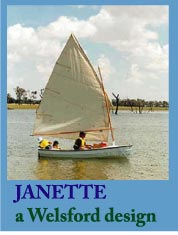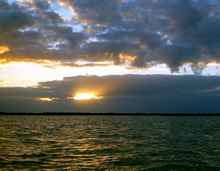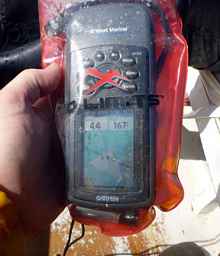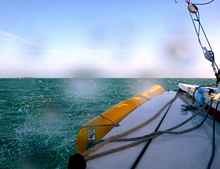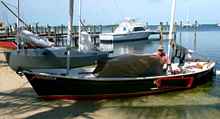
 Custom Search
|
| boat plans |
| canoe/kayak |
| electrical |
| epoxy/supplies |
| fasteners |
| gear |
| gift certificates |
| hardware |
| hatches/deckplates |
| media |
| paint/varnish |
| rope/line |
| rowing/sculling |
| sailmaking |
| sails |
| tools |
| join |
| home |
| indexes |
| classifieds |
| calendar |
| archives |
| about |
| links |
| Join Duckworks Get free newsletter CLICK HERE |
|
|
| EC 2016 - Part Four |
by Gary and Helen Blankenship, Tallahassee, Florida - USA
|
Part One - Part Two - Part Three - Part Four I didn’t set an alarm because sleep was the priority. We got up around dawn and had breakfast and began readying the boat. The rough plan had been to leave in midafternoon sail through the first channel down to Man of War, anchor for the night, and then leave first thing Thursday morning. But the wind, while still strong, had not built up to the predicted velocity and it seemed like we were wasting good sailing time. So we loaded up and departed at 10:30. This is where I made the slight mistake. We should have set things out to dry the previous day, gotten an hour or so of sleep, maybe gotten a quick meal, and then departed around 4 to 4:30 p.m. We would have made it to Man of War by dark or perhaps only to Clive Key, at the end of the first channel. But we would have been able to anchor in calm water and would have gotten the same amount of sleep we got at Flamingo, albeit without the same ability to stretch our legs. Most importantly, we would have departed at dawn the next day, with part of the last leg already done and five hours ahead of where we were the next day. As it was, instead of having light for a good part of the last run up the Intracoastal Waterway, we did it all in the dark. Both Bill and Graham adopted that strategy when they left on Tuesday. John and Will intended to stop but were making such good time initially that they pressed on and finished – a decision they may have somewhat regretted. The last part of their trip was like ours: dark, windy, rough, and wet.
At any rate, Gary and I quickly made it to the Murray/Clive channel, which runs south and south-southeast past those two keys. John later told me he and Will and no trouble sailing the channel. Apparently by Wednesday, the wind had shifted a bit more southerly and we had to do long and short tacks. Fortunately, it was about half tide so there was 12 to 18 inches of water on either side of the channel and we were able to do shallow tacks. If it had been low tide, we would have had to wait for the water to rise. Eventually, we made it through and headed across the shallow sound south of the channel. One short tack at the southern end brought us to Man of War channel. Since it tends to the west of south, we sped through at about 5 knots. Emerging from the channel around 1:30, Oaracle was protected somewhat by the shallow Nine Mile Bank, about a mile to the east. It was still fairly choppy and I remember looking at the water and seeing steady white streaks of foam blown by the wind, which was probably around 25 knots at that point.
Fortunately, the wind eased slightly as we worked around the bank and came hard on the wind. It was a slog, but by 4:15 we reached the ICW south of Arsenic Bank and began the beat across the south side of Florida Bay. This is perhaps the most tedious part of the course around the bay. There are no landmarks, the strong headwind makes for rough water (although not as bad as we had entering Florida Bay on Tuesday), and the spray flies. In fact, this from this point until the finish is probably the wettest sailing in terms of spray I’ve ever done. Getting to the ICW south of Florida Bay seemed fairly quick.
The four hours to get to Bowlegs Cut, the first pass when we reached the Atlantic ICW which we would follow to Key Largo, seemed like an eternity. The speed wasn’t bad, but tacking a light boat into strong winds and choppy seas guarantees a fair amount of leeway.
As we got close to Bowlegs, the speed dropped to around 3 knots in the rough seas. I didn’t mind too much, since it was fully dark and it would give us time to use the spotlight to pickup up the unlit channel markers between the lit markers at each end of the cut. Perversely either the seas calmed or there was a current and our speed went to 6 knots at the cut. We made it through, but there was the sensation of running an obstacle course while blindfolded. Immediately on the other side, the speed dropped again. Not quite two hours later, the same thing happened when we reached the cut in Shell Key Bank. We scraped through again. We couldn’t quite hold the course for most of the ICW and had to do some short tacks, but the GPS kept us out of trouble. Two more hours of hard sailing brought us to Cowpens Cut in Cross Bank, where the high mangroves cut off the cross wind. As on my two previous trips through, we caught a favorable current and rowed through with little trouble. From Cowpens, you can almost sense the finish, which on a straight line is less than 10 nautical miles away. But it’s no time to relax. There are several turns in the ICW, unlit markers for private channels just outside the ICW, and unlit ICW markers. It was one of the latter that brought us some grief. We had spotted the red marker with the flashlight and I thought we would pass it with ease and turned the light away. But there was a shift in the wind that luffed the sail just before we cleared it. I was slow to realize the shift and Gary tried to steer away, but we lost momentum. By the time he turned back to catch the wind, it was too late and we rushed to the port side to fend off the marker. We both have vivid memories of seeing the triangular marker sign outlined in the mainsail, lit by the stern light, as we slid by. Fortunately, it did not rip the sail. The post bounced heavily on the stern quarter and apparently snagged the rigging of the small mizzen. There was a snap and the mizzen sagged backwards, but stayed with the boat. We were lucky. A homemade fiberglass strap around the top of the tube in which the mizzen is stepped had broken. The base of the tube, which sits in another homemade fiberglass step, had pivoted inward and put a small crack in the transom. But the mast, boom, sprit, and boomkin were undamaged. I cut away the sheet and the line that holds the boomkin in place, bundled up the whole rig (the mizzen is all of about 12 square feet so all the spars are small and light), and put it in the cabin. We were back underway in a couple minutes. Oaracle went a little further and then we hit a shoal. Peering through spray covered glasses at the GPS, which was in a clear waterproof pounch and also covered with saltwater, I had mistaken a wildlife area boundary for the channel boundary and let us drift north of the deep water. Fortunately, the boat only scrapped a couple times and then slid free. (We didn’t know it at the time, but the channel marker we bounced off had somehow grabbed a line off the stern and jammed it between the rudder and it’s pivoting blade, firmly fixing it in the down position. That’s what bumped. We might have stopped if the water had been a bit shallower.) Suitably chastened, we got Oaracle back in the ICW, and then reached the short section that heads west of north. No longer hard on the wind, we sped up and were free for a blessedly short time from the spray. The channel turned back to the northeast and a couple tacks – and careful navigation around the unlit channel markers – brought us through Baker Cut and into Buttonwood Sound. I had avoided counting down the distance to the finish, which might prove discouraging if we encountered an unexpected delay. Now I looked at Gary and said, “Do you know where we are?” “No,” he said. “We’re there.” I pointed to a giant radio tower on shore, now less than a mile away. Of course, it wasn’t quite that easy. It was still upwind and it took a long tack to get there. As we closed the shore and the waves finally started to die off and the spray stopped flying, we flashed a light towards the finish. We got a very bright light flashing back. John Bell had set his alarm, in the best spirit of Watertribe, to ensure he would be there to meet us. Even though it was 3:30 a.m. on Thursday morning when we got there. It was 17 nonstop hours since we slipped away from the dock in Flamingo and certainly one of the toughest sails I had ever done. We were wet, tired, perhaps like Oaracle a bit sore, but overall grateful to be there. Fourth leg perspective from a first timer: So we were most of the way to finish. Seems easy, another long sail, we get to the finish, have a beer and enjoy a little break in Key Largo. We got this. We leave Flamingo under nice weather and we are well rested. Oaracle makes her way across the bay and we head down the first channel. This should be described as a tunnel not a channel. We tacked well… frequently. After tack number 13,567 we reached the end of the channel and headed for the next one which literally a cake walk compared to the first. Once free the channels we had a few hours of somewhat smooth sailing. Once we reached the intercostal waterway we turned in a more northern direction to Key Largo and the fun began. Now commences hour after hour of wind and water in our faces. Literally! The next nine or so hours became crash into the waves and then have an imaginary deckhand empties a five-gallon pail of saltwater directly into our faces. Our foul weather gear failed us and we spent hours soaked to the skin. The seas were rough enough that any rest was out of the question and the only thing to do was keep going. After the sun set, the only thing that changed was that our wet slog become a dark wet slog. Are we having fun yet? Somewhere well after dark we were navigating a channel marker and I could see that our forward progress had ceased and our sideway progress was enhanced. I was slow to react; we moved right into the channel marker and watched the outline of the metal triangle sign move through the sail. By some gift from the wind gods the sail did not tear or rip. However, once the sail passed the sign, it regained power and took the side of the boat directly into the post of the marker, then carried the transom of the boat around so that it got a good whacking from the post as well. The poor mizzen took the brunt of the damage and was de-masted from its supports. Gary quickly cut its lines and without ceremony retired it to the cabin. (Important note: Gary’s boat, which he built with his hands, has just had its mizzen sheared off and his response is “nothing that can’t be fixed” with no words of the cursing kind uttered- he might be a higher order being.) Oaracle was now a single mast boat but we are still heading to Key Largo and making good time. The rest of the night continued on as before with salty splash greetings every few seconds. As the night progressed there was a point were Gary indicated that we were just two and half miles from where we wanted to be. I ASSumed that to mean that we were nearing the finish. I ASSumed wrong and after we got the “where we wanted to be” apparently we had another 12 or 18 miles to go. It was going to be a long night. Somewhere around 2:30 in the morning Gary pointed to a tower light by bright lights. That was Key Largo. We were within sight. As we neared, someone with a flashlight signaled to us, it was our good friend MisterMoon. We were almost there. So in the middle of the night Oaracle slid into the soft sand in Key Largo and our race was over. I babbled a bit when asked some questions. I refused a beer. I don’t remember any real conversations. But we had finished and finishing was everything. We could have been the last to finish (we weren’t) and it would have been just as satisfying. A few days later I got my shark’s tooth. I would later point out that it might be the most expensive piece of jewelry in our home, not sure that my wife thinks that is funny. But aside from the tooth we had accomplished something great and as a first timer I am forever grateful that my captain brought me on aboard Oaracle and we made it to Key Largo as friends.
***** Some post-race, Class 4 thoughts from Gary B: It was a rough year in the Everglades Challenge, especially the last half of the route, and one of contrasts. For the first two days, we were mostly running and then reaching. When we came hard on the wind, approaching Cape Romano, we stayed closed hauled, if not actually beating for the rest of the course. The last part was a repeat of the 2012 challenge, when a high pressure system parked off the Atlantic coast and pumped strong east to east-southeast winds over southwest Florida and Florida Bay. About 90 kayaks and sailboats in six classes left the Ft. Desoto on Saturday; by the following Saturday 35 of them reached Key Largo. Four stopped at Flamingo and 23 got at least as far as Chokoloskee. I talked with some of those later. Some left CP2 and found the winds too strong or they felt the head winds wouldn’t leave them enough time to finish in eight days. Some looked at the weather forecast and decided on discretion. The shortest monohulls to finish were John Bell and Will Nye in their open Core Sound 17, and Graham Brynes in his Core Sound Mk III, which has a cozy cabin that I lust after. Donald Polakovics with his skinny, beautiful rowing and sailing craft was probably the lightest. There were a number of smaller monohulls in the 14-foot to 16-foot range, mostly single handed. None finished, except for Marian Buszko (RockingBaby) who had a CLC Skerry in class 6 that was outfitted both for sail and electrical power. (The May/June issue of Small Craft Advisor has a feature on the CLC Skerry, with a mention of the modifications made for RockingBaby’s boat.) A new wrinkle this year is Chief experimented with allowing a Class 4 entry with three, instead of one or two, crew. I’m not sure if they were in a specially built boat, and Jeff Linton and Jahn Tihansky (TwoBeers and Morsailesed, the third crew member isn’t listed in tribal records) finished in a blazing 36 hours and change. They were able to take the direct route across Florida Bay. A quick look at other sailing finishers appears to show that everyone else went around all or most of Florida Bay. The next Class 4 competitors to finished (after three multihulls) were Kilby Smith and Stephen Antworth (SkinnyGenes and Skinanyjeans) in a wooden Thistle in 2 days, 17 hours and 36 minutes, and they were followed by less than an hour later by Michael Lingswiler and Tom Bremen (Halfbaked and Clacker) in a Phil Bolger-designed, Edey & Duff-built Dovekie. From their track, they tried the direct route across Florida Bay but had to turn around. They cut across Nine Mile Bank and Rabbit Key Basin on the south side of Florida Bay, something I’ve never had the nerve to try. SkinnyGenes and Skinnyjeans also started Florida Bay, but cut south at the start of Tin Can Channel. They went south, and then there’s a gap in their satellite track until they emerge, several hours later, from Rabbit Key Basin. The GPS registered a total of 304 nautical miles sailed over 81 hours at an average speed of 3.7 knots. Gary’s can go on Sunday in Pine Island Sound, the average speed had peaked at 4.6 knots, an indication of how fast we had run the previous afternoon and that morning. Even after hitting the slop in southern Pine Island Sound, Oaracle did more than 100 nautical miles in the first 24 hours of sailing time, one of the fastest protracted sailing periods in the boat’s history. The 12 nautical miles done in Pine Island Sound in 1:45 is probably the fastest the boat has run that distance in mostly flat water. All in all, quite a ride. And Gary S. should be suitably proud. Despite his captain’s best efforts to dump him and the entire boat in Stump Pass, he persevered and I believe was one of the very few first timers to reach the finish this year. |
To comment on Duckworks articles, please visit one of the following:
|
 |

